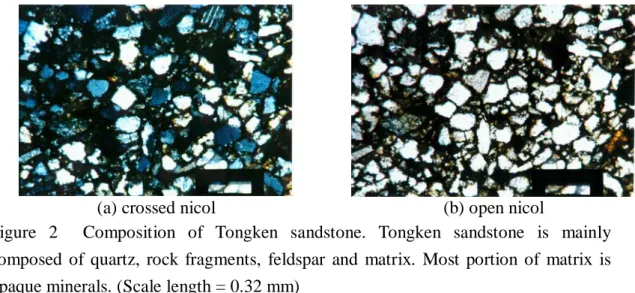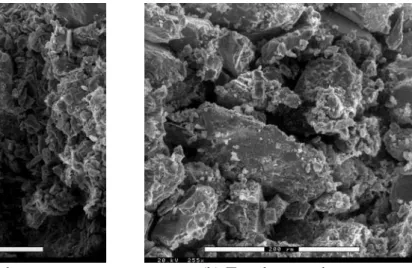A STUDY ON THE MICROSCOPIC MECHANISM OF SANDSTONE’S WETTING SOFTENING
Fu-Shu Jeng Meng-Chai Weng Tsang-Hwei Huang
Department of Civil Engineering, National Taiwan University, Taipei, Taiwan, ROC
ABSTRACT
This study focuses on wetting softening of sandstone and associated microscopic mechanism. The variation of macroscopic behavior, strength and deformability, of sandstone with moisture was investigated from experiments. Accordingly, the microscopic features, including petrographic characteristics (mineral composition and grain contact), porosity as well as the pattern of fracture propagation, are then evaluated to reveal their influence on the macroscopic mechanical behavior.
The microscopic observation indicates that, when sandstone is wet, fracture is formed by the coalescence of cracks within matrix between grains. However, when sandstone is dry, cracks may be developed either in matrix or in grains. This indicates that the matrix is softened when it is wetted, which enables cracks to propagate through it. On the other had, it was found that the matrix is mainly composed of clay minerals. As the clay minerals are inherently to be softened when wetted, it is suspected that the existence of the clay minerals is one of the factors accounting for the wetting softening.
Key Words: wetting softening, microscopic mechanism
INTRODUCTION
Most of the rocks in Western Taiwan are Tertiary soft rocks such as sandstone, shale, and mudstone. Owing to the juvenile rock forming process, these rocks exhibit weakness not only in strength but also in the capability of resisting weathering. Furthermore, these rocks possess undesired characteristics, including wetting softening, shear dilation and creep as well, which causes lots of problems in engineering practice, especially in tunneling engineering (Jeng et al., 1996).
Among these undesired characteristics, wetting softening is one of the most suspicious factors inducing squeezing condition. Jeng (1996) performed tests on sandstone and found that: the compressive strength, shear modulus and bulk modulus
decreases 60%, 60% and 70% respectively when the dry sandstone is soaked in water for 120 minutes. Given such a dramatic change in mechanical properties, it is interested to identify the microscopic mechanism inducing the wetting softening. Therefore, this research aims at exploring the possible microscopic characteristics, including mineral composition, porosity, grain contact and pattern of fracture propagation, which results in wetting softening.
EXPERIMENT CONCEPT
In order to understand the mechanism of sandstone’s wetting softening, this research performs two aspects of tests: one is uniaxial compressive strength of two kinds of sandstones at dry condition and four specified humidites and the other is petrographical analysis. Sandstone specimens cored from Mushan Formation and Tongken Formation are selected.
In the mechanical tests, uniaxial compressive strength was determined according to the ISRM suggested method, and the levels of saturation of the specimens are controlled at 100%, 80%, 40%, 25%, 0%.
In the petrographic analysis, the texture of sandstones was observed by polarized microscope and scanning electron microscope (SEM). Using polarized microscope, the mineral composition of grain, grain contact type, matrix content and pore content were examined and recorded (Figure 1 & 2). SEM was used to examine the fracture phenomena of sandstone after the specimens were tested.
EXPERIMENT RESULTS
Results of Uniaxial Compressive Tests
The mean uniaxial compressive strength of dry Mushan sandstone is 47.6 MPa, and the mean deformability modulus is 7.56 GPa. According to the definition of ISRM, Mushan sandstone is classified as moderate strength rock.
The mean uniaxial compressive strength of dry Tongken sandstone is 72.6 MPa, and the mean deformability modulus is 5.20 GPa. Accordingly, Tongken sandstone is classified as medium strength rock.
Figure 3 and Figure 4 illustrate the influence of degree of saturation on the normalized strength and the normalized deformability modulus. For Mushan sandstone, as the degree of saturation increases from 0 % to 100 %, the normalized strength decreases 40 % and the normalized deformability modulus decreases 43 % as well. For Tongken sandstone, the normalized strength decreases 57 % and the normalized deformability modulus decreases 54 % while the degree of saturation increases from 0 % to 100 %. Notably, sandstone lost most of its “dry strength” as the degree of saturation exceeds 80%. As revealed by the experimental results, the
strength of sandstone is substantially softened when wetted. Therefore, to maintain a “dry” ambient condition during tunnel construction can be helpful for preventing unnecessary wetting softening and associated engineering difficulties.
Results of Petrographic Analysis
The rock texture observed by polarized microscope includes two aspects: one is the mineral composition, and the other is the geometrical feature of grain. The analysis of mineral composition is summarized in Table 1. Mushan sandstone and Tongken sandstone are mainly composed of quartz, rock fragments, and matrix which is mainly consist of clay minerals. The discrepancy in mineral composition is insignificant. According to sandstone classification (Pettijohn et al., 1973), both Mushan sandstone and Tongken sandstone are classified to lithic sandstones.
The geometrical feature of grain includes the mean grain size and the grain contact type. The mean grain sizes of Mushan and Tongken Sandstones are 0.2 mm and 0.04 mm, respectively. That is, the grain size of Tongken sandstone is only one fifth of that of Mushan sandstone.
Based on grain contact classification by Dusseault & Morgenstern (1979), the grain contact types are categorized into five classes: non-contact type, tangent type contact, linear type contact, inlay type contact and suture type contact. The grain contact types of the two sandstones are summarized in Table 2. As indicated by
Table2, both of the Mushan sandstone and the Tongken sandstone posses “grain contact” nature instead of “matrix support”. (The counts of grain-to-grain contact of these two types of sandstone are 92.0 % and 79.9%, respectively.)
Fracture phenomena of sandstones
As revealed by SEM observation, wetting of sandstone has significant influence on the behavior of crack development. As the sandstone is dry, cracks may be observed either within grains or within matrix as shown in Figures 5, in which the grains were broken (or penetrate by cracks) after failure. However, as the sandstone is wet, cracks only occurred with matrix. As shown in Figures 6, all the grains of wet sandstone remain intact after failure, coated with matrix material on the grain surface. Therefore, the crack did not penetrate the grains and propagated through the matrix only. This phenomenon is observed for both Mushan and Tongkeng sandstone.
When the sandstone is wetted, the matrix may be more softened than the grains such that the matrix is much weaker and possibly softer. This inherently allows the grains to displace and to rotate to accommodate the applied loading and hence stress concentration is less possible to be induced during the loading process.
Consequently, the grains were not fractured and cracks only propagate through matrix. Meanwhile, as the strength is controlled by the weaker and softened matrix, the global strength of sandstone is accordingly reduced.
CONCLUSIVE REMARKS
(1) Based on the mechanical tests and the petrographic analysis, wetting softening in both sandstones is significant. As the degree of saturation increases from 0 % to 100 %, the strength decreases 40 % in Mushan sandstone, and 57 % in Tongken sandstone.
(2) From fracture phenomena observation, the difference of dry and water-saturated condition is obvious. When sandstone is wet, fracture is formed by the coalescence of cracks within matrix between grains. However, when sandstone is dry, cracks may be developed either in matrix or in grains.
(3) The global wetting softening of sandstone may be resulted from matrix softening. As the matrix contents clay minerals, the matrix potentially may be softened while it is wetted, which enables cracks to propagate only through it. Therefore, the existence of the clay minerals may one of the factors accounting for the wetting softening.
REFERENCES
1. Jeng, F. S., I. T. Lee and T. H. Huang (1996). Deterioration of Soft Rock Induced by Wetting Process. Proc. Of ’96 Taiwan Rock Engineering Symposium. Taipei, Taiwan, 373-382.
2. Jeng, F. S., M. L. Lin and T. H. Huang (1996). Study of the Geological Barriers of the
tunnels in Northern Taiwan, Research Report MOTCSTAO-RD1501, Ministry of
Transportion, Taipei.
3. Chu, Ling-I (1998). The Microscopic Mechanism of Sandstones Weakening, Master thesis, dept. of Civil Eng., National Taiwan University, Taipei, Taiwan.
4. Pettijohn, F. J., Potter, P. E. and Siever, R. (1973), Sand and Sandstone, Springer-Verlag, Berlin.
5. Dobeyreiner, L. and De Freitas, M. H. (1986), “Geotechnical Properties of Weak Sandstone.”, Geotechnique, 36(1), 79~94.
6. Lama, R. D. and Vutukuri, V. S. (1978), Handbook on Mechanical Properties of Rock, Vol.2, Trans. Tech. Public., 57~59.
Table 1. Mineral composition of Mushan sandstone and Tongken sandstone
Rock type Grain Matrix Pore
% % %
Mushan
sandstone 66.7 29.3 4.0
Tongken
Table 1 (cont’d) Mineral composition of Mushan sandstone and Tongken sandstone
Rock type
Grain Quartz Feldspar Rock
Fragment Mica Others Subtotal
% % % % % %
Mushan
sandstone 57.1 0.4 8.4 0.3 0.5 66.7 Tongken
sandstone 54.2 2.3 8.6 1.4 0.6 67.1
Table 2. Types of Grain contact of Mushan sandstone and Tongken sandstone
Rock type Non-contact
Tangent Type Linear type Inlay type Suture Type % % % % % Mushan sandstone 8.0 61.0 22.2 8.8 0.0 Tongken sandstone 20.1 66.7 10.3 2.9 0.0
(a) crossed nicol (b) open nicol
Figure 1 Composition of Mushan sandstone. Mushan sandstone is mainly composed of quartz, rock fragments and matrix. (Scale length = 0.64 mm)
(a) crossed nicol (b) open nicol
Figure 2 Composition of Tongken sandstone. Tongken sandstone is mainly composed of quartz, rock fragments, feldspar and matrix. Most portion of matrix is opaque minerals. (Scale length = 0.32 mm)
y = 1.1342x-0.142 y = 1.1532x-0.2058 0.3 0.4 0.5 0.6 0.7 0.8 0.9 1.0 0.0 20.0 40.0 60.0 80.0 100.0 Degree of Saturation (%) Nor mal ized St rengt h Mushan sandstone Tongken sandstone Regressional curve of Mushan sandstone Regressional curve of Tongken y = 1.1085x-0.1636 y = 1.0958x-0.1798 0.3 0.4 0.5 0.6 0.7 0.8 0.9 1.0 0.0 20.0 40.0 60.0 80.0 100.0 Degree of Saturation (%) Nor mal ized Def or mabi lt y Modul us Mushan sandstone Tongken sandstone Regressional curve of Mushan sandstone Regressional curve of Tongken
Figure 3 Variation of normalized strength with degree of saturation.
Figure 4 Variation of normalized deformability modulus with degree of saturation
(a) Mushan sandstone (b)Tongken sandstone
Figure 5 Outlook of fractured grains from dry sandstone after loading.
(a) Mushan sandstone (b) Tongken sandstone


